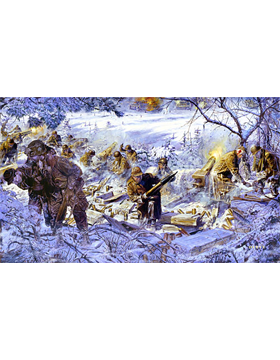WWII Unframed Canvas Print Stopped Cold
Item #UCP-JD022
Product Spec Sheet
Description
101st Airborne Division at the Battle of the Bulge On 17 December 1944, the Artillery Battalions of the 101st Airborne Division were alerted and given 24-hour notice to move to positions in Belgium to assist in halting a massive German offensive through the rugged terrain of the Ardennes region. Hitler's last western Offensive, with the final objective being to seize the port facilities at Antwerpt, would become known as the Battle of the Bulge. The acting Division Commander of the 101st Airborne Division was the Division Artillery Commander, Brigadier General Anthony C. McAuliffe. He would lead the division to Bastogne and earn the Screaming Eagles a place in American military lore. Depicted in the work of James Dietz is the 321st Glider Field Artillery Battalion firing from their positions near the town of Savy, approximately one kilometer northwest of Bastogne, in direct support of the 506th Parachute Infantry Regiment who were heavily engaged northeast of the Bastogne perimeter. Not fully refitted from the Holland Campaign which occurred just weeks before, the 321st conducted the 107 mile road march from Mourmelon, France to the small village of Savy, Belgium and reported laid and ready to fire by 1330, 19 December. The battalion would occupy this position for 25 days providing intense fire support to all areas of the encircled Division perimeter. During the siege, the battalion endured constant enemy shellfire and was strafed and bombed by aircraft. Few casualties were sustained by the battle-hardened cannoneers due to excellent dispersal and well dug in howitzer positions. Fighting not only the Germans but severe cold, lack of protective clothing, food and constant ammunition shortages, the artillerymen waged a desperate struggle in providing a protective ring of steel around the besieged encirclement. Firing from the open field positions to gain 6400 mils capability the artillery battalions of the 101st fired countless thousands of rounds into the Nazi juggernaut. On Christmas Day, three German tanks broke through the Western line of defense and reached the woods 500 meters from the firing batteries of the 321st. Bursting through the wood line and into the open fields the tanks came spraying a hail of tracers. In just seconds the enemy armor was put out of action by a combined effort of American tank destroyers and artillery. In a Christmas greeting to the soldiers of his division, Brigadier General McAuliffe stated: "...We have stopped cold everything that has been thrown at us from the North, East, South and West. Enemy units, spearheading the last desperate German lunge, were headed straight west for key points when the Eagle Division was hurriedly ordered to stem the advance. How effectively this was done will be written in history, not alone in our Division's glorious history but in world history..." The following day elements of the 4th Armored Division broke through from the South and broke the encirclement of Bastogne. This print commemorates the valiant actions of all the artillerymen of the 101st Airborne Division Artillery during the battle of the Bulge - the 321st Glider Field Artillery Battalion, the 907th Glider Field Artillery Battalion and the 377th Parachute Field Artillery Battalion. Image Size: 30" x 17.75" Public Edition, Signed and Numbered
Sizes
| 30 in x 17.75 in |

